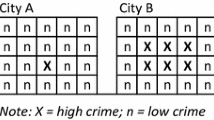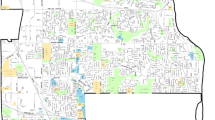Abstract
Objective
We address four outstanding empirical questions related to the “law of crime concentration” (Weisburd in Criminology 53:133–157, 2015): (1) Is the spatial concentration of crime stable over time? (2) Do the same places consistently rank among those with the highest crime counts? (3) How much crime concentration would be observed if crimes were distributed randomly over place? (4) To what degree does the spatial concentration of crime depend on places that are crime free?
Methods
The data are annual counts of violent and property crimes in St. Louis between 2000 and 2014. Temporal stability in the spatial inequality of crime is measured by computing the fraction of crimes that occur in the 5% of street segments with the highest crime frequencies each year. The spatial mobility of crime is measured by computing the number of years each street segment appears in the top 5% of street segments. Poisson simulations are used to estimate the fraction of crimes that could appear in the top 5% of street segments on the basis of chance alone. The impact of crime-free locales on the spatial concentration of crime is evaluated by comparing results from analyses that include and exclude crime-free street segments from the crime distributions.
Results
The concentration of crime is highly unequal and stable over time. The specific street segments with the highest crime frequencies, however, change over time. Nontrivial fractions of street segments may appear among the 5% with the highest crime frequencies on the basis of chance. Spatial concentration of crime is reduced when crime-free street segments are excluded from the crime distributions.
Conclusions
The law of crime concentration is not a measurement artifact. Its substantive significance, however, should be assessed in future longitudinal research that replicates the current study across diverse social settings.


Similar content being viewed by others
References
Andresen M, Linning SJ, Malleson N (2016) Crime at places and spatial concentrations: exploring the spatial stability of property crime in Vancouver BC, 2003–2013. J Quant Criminol. doi:10.1007/s10940-016-9295-8
Braga AA, Bond BJ (2008) Policing crime and disorder hot spots: a randomized controlled trial. Criminology 46:577–607
Braga AA, Papachristos AV, Hureau DM (2010) The concentration and stability of gun violence at micro places in Boston, 1980–2008. J Quant Criminol 26:33–53
Braga AA, Hureau DM, Papachristos AV (2011) The relevance of micro places to citywide robbery trends: a longitudinal analysis of robbery incidents at street corners and block faces in Boston. J Res Crime Delinq 48:7–32
Clarke RV, Eck JE (2007) Understanding risky facilities. US Department of Justice, Office of Community Oriented Policing Services, Washington, DC
Curman Andrea S N, Andresen MA, Brantingham PJ (2015) Crime and place: a longitudinal examination of street segment patterns in Vancouver, BC. J Quant Criminol 31:127–147
Eck JE, Clarke RV, Guerette RT (2007) Risky facilities: crime concentration in homogeneous sets of establishments and facilities. Crime Prev Stud 21:225–264
Fields GS, Ok EA (1999) The measurement of income mobility: an introduction to the literature. In: Silber J (ed) Handbook of income inequality measurement. Springer, New York
Gorr WL, Lee Y (2015) Early warning system for temporary crime hot spots. J Quant Criminol 31:25–47
Groff EE, Weisburd DL, Yang S-M (2010) Is it important to examine crime trends at a local “micro” level? a longitudinal analysis of street to street varaibility in crime trajectories. J Quant Criminol 26:7–32
Hope T (2015) Generating processes of the crime victimization frequency distribution, working paper. University of Salford, Salford
Hope T, Norris PA (2013) The frequency distribution of crime victimization. J Quant Criminol 29:543–578
Madensen TD, Eck JE (2008) Violence in bars: exploring the impact of place manager decision-making. Crime Prev Community Saf 10:111–125
Park SM, Eck JE (2013) Understanding the random effect on victimization distributions: a statistical analysis of random repeat victimizations. Vict Offenders 8:399–415
Pierce GL, Spaar S, Briggs LR (1988) The Character of police work: strategic and tactical implications. Center for Applied Social Research, Northeastern University, Boston
Piketty T (2000) Theories of persistent inequality and intergenerational mobility. In: Atkinson AB, Bourguignon F (eds) Handbook of income distribution, vol 1. Elsevier, Amsterdam
Sherman LW, Gartin PR, Buerger ME (1989) Hot spots of predatory crime: routine activities and the criminology of place. Criminology 27(1):27–55
Sorg ET, Haberman CP, Ratcliffe JH, Groff ER (2013) Foot patrol in violent crime hot spots: the longitudinal impact of deterrence and posttreatment effects of displacement. Criminology 51(1):65–101
Spelman W (1995) Criminal careers of public places. In: Eck JE, Weisburd D (eds) Crime and place: crime prevention studies 4. Willow Tree Press, Monsey
Weisburd D (2015) The law of crime concentration and the criminology of place. Criminology 53:133–157
Weisburd D, Bushway S, Lum C, Yang S-M (2004) Trajectories of crime at places: a longitudinal study of street segments in the city of Seattle. Criminology 42(2):283–322
Weisburd D, Eck JE, Braga AA et al (2016) Place matters: criminology for the twenty-first century. Cambridge University Press, New York
Weisburd D, Groff E, Yang SM (2012) The criminology of place: street segments and our understanding of the crime problem. Oxford University Press
Weisburd D, Morris NA, Groff E (2009) Hot spots of juvenile crime: a longitudinal study of arrest incidents at street segments in Seattle, Washington. Journal of Quantitative Criminology 25(4):443–467
Wolfgang ME, Figlio RM, Sellin T (1972) Delinquency in a birth cohort. University of Chicago Press, Chicago
Acknowledgements
Funding was provided by National Institute of Justice (US) (2012-IJ-CX-0042).
Author information
Authors and Affiliations
Corresponding author
Rights and permissions
About this article
Cite this article
Levin, A., Rosenfeld, R. & Deckard, M. The Law of Crime Concentration: An Application and Recommendations for Future Research. J Quant Criminol 33, 635–647 (2017). https://doi.org/10.1007/s10940-016-9332-7
Published:
Issue Date:
DOI: https://doi.org/10.1007/s10940-016-9332-7




